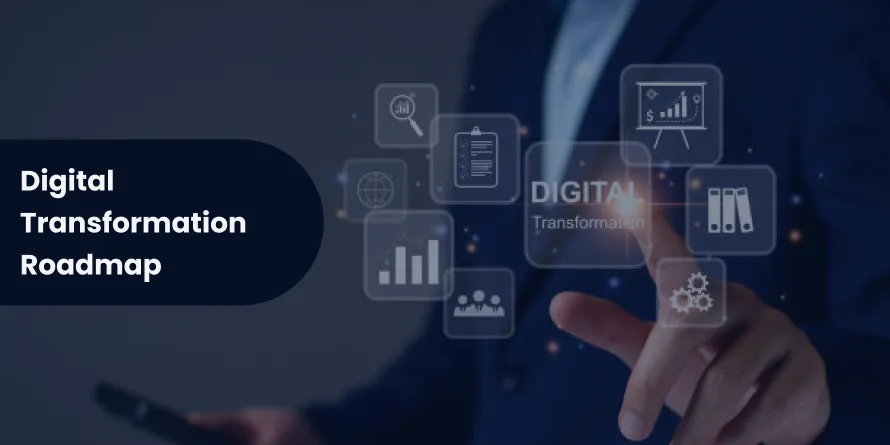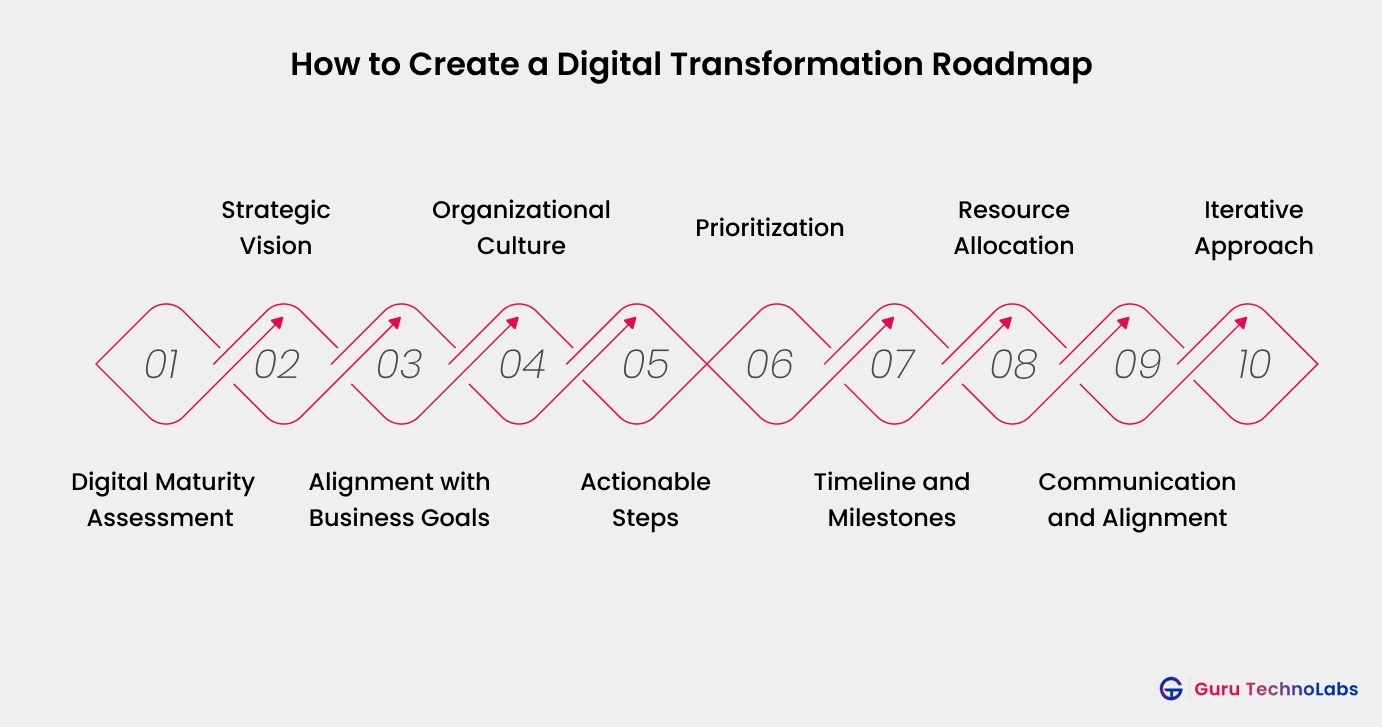How to Build a Future-Proof Digital Transformation Roadmap in 2025?

In today’s business environment, a digital transformation roadmap is more than just a buzzword, it’s a blueprint guiding your company from A to B. A well-defined roadmap helps align your technology initiatives with business goals, reduces risk, and ensures a smoother transition to digital-first operations. It provides clarity, direction, and measurable steps for sustainable transformation.
As we enter 2025, founders and business leaders must recognize that digital transformation is no longer optional. It’s the key to staying competitive, optimizing operations, and delivering exceptional customer experiences. A solid roadmap helps you navigate complex technologies and shifts with a clear direction for your business.
Creating a future-proof digital transformation roadmap means setting a clear vision for your business’s evolution while remaining adaptable to change. It involves identifying challenges, leveraging the right technologies, and making data-driven decisions. Let’s explore how to chart this critical path for 2025 and beyond.
What is the Digital Transformation Roadmap?
A digital transformation roadmap is a strategic plan that guides a business through the process of adopting digital technologies and modernizing operations. It outlines the specific steps, tools, and resources needed to shift from traditional methods to a more tech-enabled, efficient, and future-ready model. Just like using a map or GPS when navigating an unfamiliar city, a digital transformation roadmap helps businesses stay on course, avoid unnecessary detours, and reach their digital goals effectively.
This roadmap typically includes clear objectives, defined timelines, key milestones, technology selection, resource allocation, and change management strategies.
However, It ensures alignment between digital initiatives and overall business goals, helping leaders prioritize actions, reduce risks, and maximize ROI. In today’s competitive environment, a digital transformation roadmap is essential for driving innovation, improving customer experience, and achieving sustainable growth in the digital age.
Digital Transformation Strategy vs. Digital Transformation Roadmap
Many businesses face confusion between a digital transformation strategy and a digital transformation roadmap. While they are closely connected, they play very different roles in your digital journey.
A digital transformation strategy is the big-picture plan. It explains why your business needs to change, what you want to achieve, and how digital technology fits into your long-term goals.
On the other hand, a digital transformation roadmap is the action plan that shows exactly how and when you’ll reach those goals. It breaks down your strategy into smaller, manageable steps with clear timelines, responsibilities, and resources.
Here’s a breakdown to help you understand the key differences:
| Aspect | Digital Transformation Strategy | Digital Transformation Roadmap |
|---|---|---|
| Definition | A high-level plan that outlines the vision and strategic goals for digital transformation. | A step-by-step guide that breaks down how to implement the strategy effectively. |
| Purpose | To define why the business needs digital transformation and what it aims to achieve. | To detail how the business will achieve its digital goals through actions and timelines. |
| Focus | Vision, direction, innovation, and competitive advantage. | Execution, processes, tools, and task management. |
| Scope | Broad, company-wide, and long-term. | Specific, departmental or project-level, and short to medium-term. |
| Time Horizon | Long-term (typically 3–5 years or more). | Short to medium-term (6 months to 2 years). |
| Key Components | Long-term (typically 3–5 years or more). | Short to medium-term (6 months to 2 years). |
How to Create a Digital Transformation Roadmap
The digital transformation market is booming, with businesses of all sizes investing in technology to stay competitive. A recent report by Grand View Research revealed that the global digital transformation market is projected to reach $3.3 trillion by 2025, growing at a compound annual growth rate (CAGR) of 27.6%.
With such rapid growth, it’s clear that businesses cannot afford to fall behind. However, while technology offers endless opportunities, embarking on a digital transformation journey can be overwhelming without a structured approach.

To help you chart your path forward, we have broken down the 10 essential steps to create a digital transformation roadmap that will ensure your business stays ahead of the curve. Let’s dive in:
Step 1: Digital Maturity Assessment
Begin by examining your current digital capabilities. This includes evaluating your technology infrastructure, such as hardware, software, tools, and networks. Are they modern, secure, and scalable? Look at your workflows and processes, are there inefficiencies that could be eliminated through automation or better tools?
Also, review your data systems. Are you able to make decisions based on real-time, accurate data? A digital maturity assessment gives you a clear picture of your strengths, gaps, and opportunities.
Step 2: Strategic Vision
Once you’ve assessed your current state, it’s time to define a strategic vision. This is a long-term goal that reflects leadership’s ambition and where the business wants to go digitally.
Whether it’s automating operations, adopting AI, or launching new digital services, your strategic vision should act as your guiding star. It keeps your transformation focused and helps prioritize efforts.
Step 3: Alignment with Business Goals
Digital transformation should not exist in isolation, it must support your overall business goals. Whether your focus is on growing revenue, improving customer experience, streamlining internal operations, or expanding to new markets, each digital initiative must align with what the business is trying to achieve. This alignment ensures that digital investments produce real, measurable outcomes.
Step 4: Organizational Culture
Technology alone doesn’t transform a business, people do. It’s critical to assess if your organizational culture is ready for change. Are employees open to adopting new tools? Are leaders driving innovation?
This phase may also involve addressing resistance, offering digital skills training, and building a mindset that embraces experimentation and change. Without cultural readiness, even the best tools can fail.
Step 5: Actionable Steps
Identify the specific initiatives required to achieve your transformation goals. This could include migrating to cloud-based systems, digitizing customer support, or implementing an AI-powered CRM.
Each initiative should have a clear purpose, expected impact, and an owner responsible for execution.
Step 6: Prioritization
Since resources are limited, you can’t do everything at once. Use prioritization models like impact vs. effort or value vs. risk to determine which initiatives should be tackled first.
Quick wins, like automating a manual task, can deliver early results and build momentum, while larger, high-impact initiatives can follow.
Step 7. Timeline and Milestones
Once you know what to do and in what order, establish a clear timeline. Break the plan into phases, set deadlines, and define milestones to track progress.
Each milestone should have clear success indicators. This makes it easier to measure what’s working and where you need to adjust.
Step 8. Resource Allocation
Assign the right people, tools, and budget to each part of the plan. Do you need external consultants, software licenses, or internal cross-functional teams?
Proper resource planning ensures smooth execution and reduces delays caused by missing skills or underfunded projects.
Step 9. Communication and Alignment
Keep everyone involved and informed. Regular updates, team meetings, dashboards, and open communication are essential.
When all departments are aligned and stakeholders are in the loop, it leads to smoother implementation, fewer misunderstandings, and stronger collaboration.
Step 10. Iterative Approach
Digital transformation is not a one-time project—it’s an ongoing journey. Use an iterative approach: roll out changes in small phases (or sprints), gather feedback, measure outcomes, and improve continuously.
This approach allows you to reduce risk, adapt quickly, and scale what works across the organization.
Transform Your Business with Expert Digital Solutions
Ready to go digital and grow faster? Our digital transformation service helps
you streamline operations, boost profits, and stay ahead of the competition.
Our Digital Transformation Service Includes:
➤ A custom strategy tailored to your business goals
➤ The right tech solutions to improve efficiency
➤ Clear timelines and growth-focused milestones
➤ Expert support from start to finish
Tips for Deploying DX Transformation Roadmap
According to Gartner, 70% of businesses are investing in or have already implemented digital transformation initiatives, and 72% of organizations report that their investments have been critical to improving overall business performance. But while these statistics reflect the growing adoption of digital transformation, the deployment process can still be challenging.
To succeed, businesses must approach this process with a structured plan, keeping in mind both the obstacles and opportunities that lie ahead. Here are some crucial tips for deploying your digital transformation roadmap effectively:
Start with a Clear Vision and Strong Leadership
One of the first things you need to do when deploying your digital transformation roadmap is to ensure that leadership is aligned with the vision.
Invest in the Right Talent and Expertise
A successful transformation needs skilled people driving the changes. You might consider working with a digital transformation service provider to help fill gaps in knowledge and technical expertise.
Embrace Change Management
Digital transformation isn’t just about technology—it’s about transforming the culture and mindset of your employees. Ensure that change management is part of your roadmap.
Implement Agile Practices
Your digital transformation roadmap should be flexible enough to accommodate changes. Agility is essential, especially as technology and market demands evolve quickly.
Focus on Data-Driven Decision Making
One of the core advantages of digital transformation is the ability to harness data for smarter decision-making.
Monitor KPIs and Adapt
Track your progress at every stage. Use key performance indicators (KPIs) to monitor whether your digital transformation goals are being met.
Scale and Optimize
As your digital transformation takes hold, be ready to scale your solutions. Once you’ve successfully implemented smaller initiatives, build upon them by rolling out more advanced tools and strategies across the organization.
Transform Digitally with Guru TechnoLabs
Starting a digital transformation journey might feel overwhelming, but with the right roadmap and expert guidance, it turns into a valuable opportunity for growth and innovation. At Guru TechnoLabs, we understand the complexities and nuances of digital transformation, and we’re here to help you navigate every step of the process.
Digital transformation doesn’t have to be overwhelming when you have the right partner by your side. With our tailored solutions and experienced professionals, we can help you create a digital transformation roadmap that’s aligned with your business goals and ready to drive long-term success.
Get started with us today to discover how we can help you transform your business and thrive in the digital era.
Frequently Asked Questions
Digital transformation refers to the process of integrating digital technologies into all areas of a business, fundamentally changing how the organization operates and delivers value to customers.
While digital transformation is about reimagining business processes, models, and customer experiences through digital technologies, digital optimization focuses on improving existing systems and processes to make them more efficient.
A digital transformation roadmap provides a structured plan that guides businesses through the complex process of adopting new technologies and changing operational strategies.
Digital transformation can significantly enhance customer experience by providing more personalized, efficient, and convenient interactions. From AI-powered chatbots to personalized marketing campaigns, it allows businesses to engage with customers in real-time, meets their specific needs, and offer seamless experiences across multiple touchpoints—whether online, in-store, or on mobile.
Several key technologies such as cloud computing, AI, big data, IoT, and automation tools are driving digital transformation and helping businesses improve efficiency, reduce costs, and stay competitive in an increasingly digital world.





















